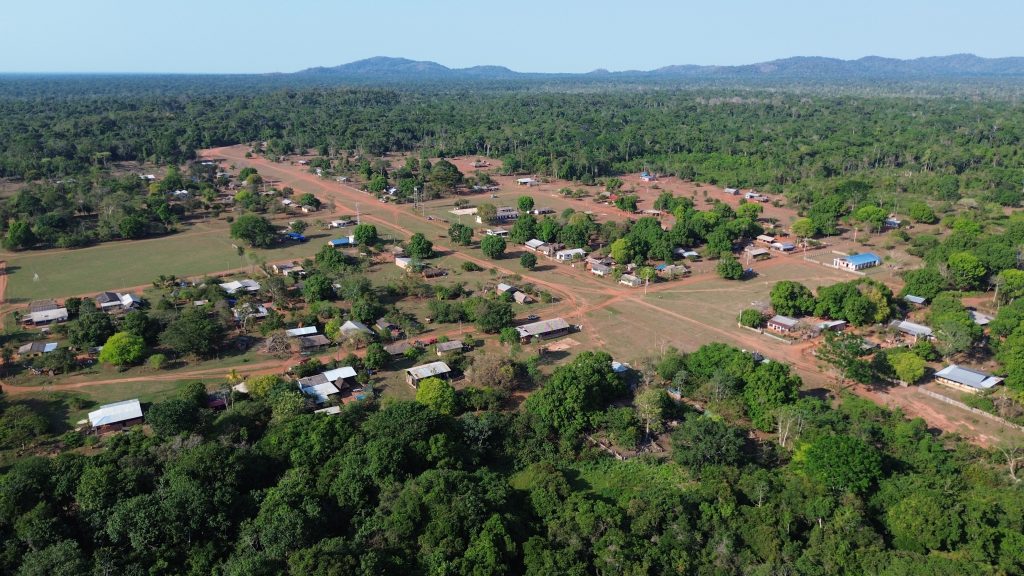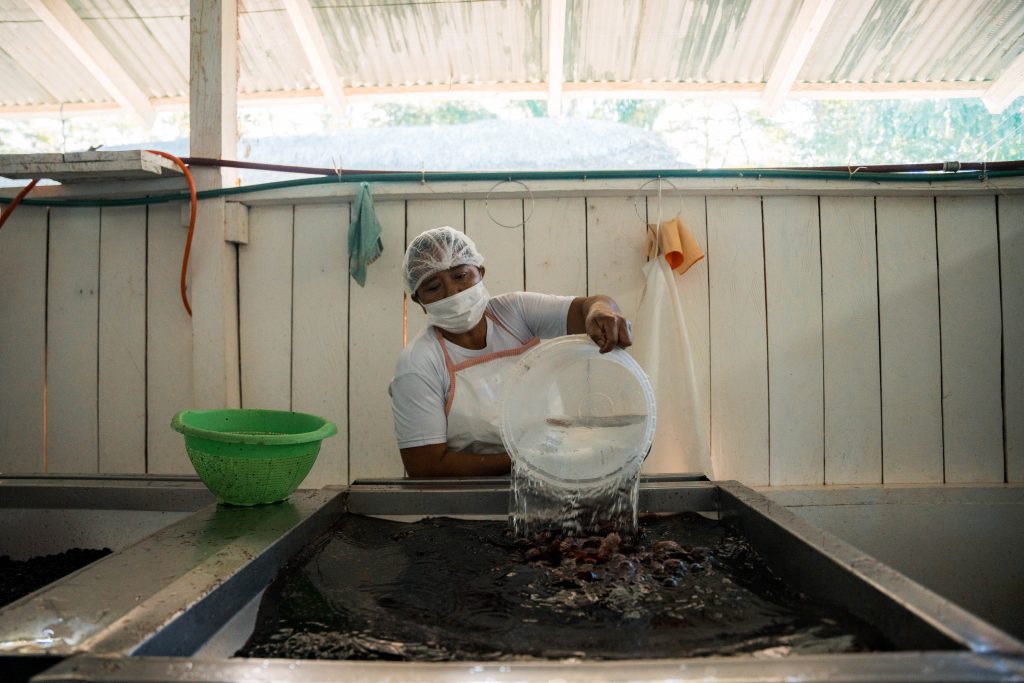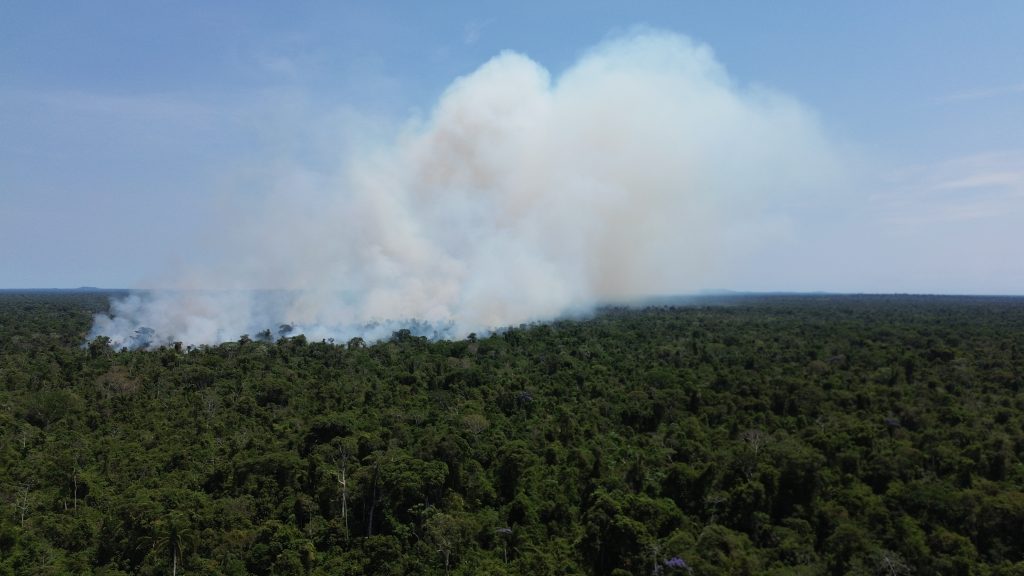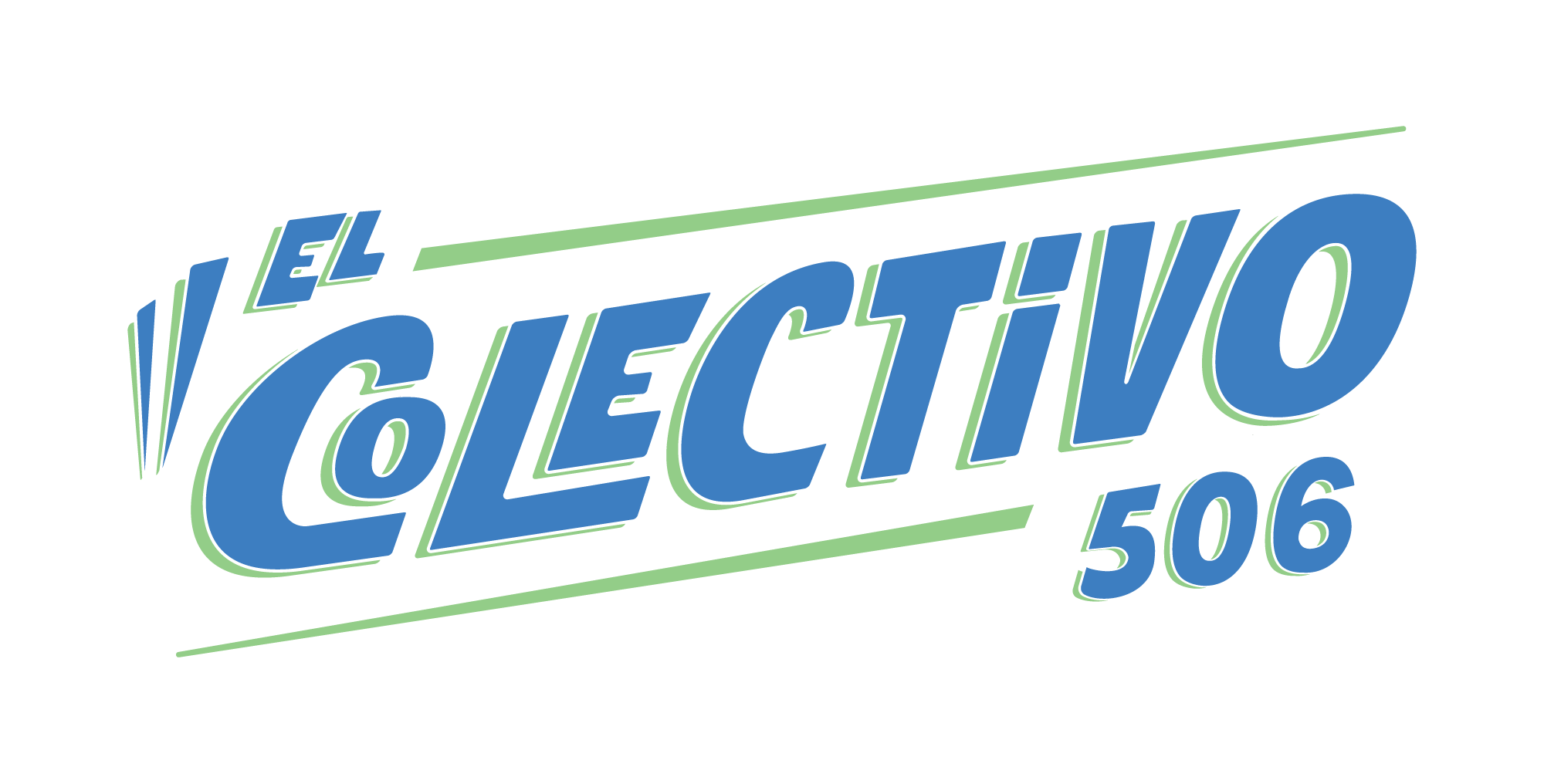In the Bolivian Amazon, a small Indigenous community demonstrates that asaí can be more than just a global superfood: it’s also a tool for conserving forests, resisting fires, and changing destinies.
Journalist Lisa Mirella Corti tells the story in this article produced with the support of the Latin America Solutions Journalism Fund, an initiative of El Colectivo 506, with support from Earth Journalism Network and its Biodiversity Media Initiative. It was published by Revista Nómadas on Nov. 18, 2025, and has been adapted by El Colectivo 506 for co-publication. ChatGPT was used to create the first draft of the translation.

A slender palm holds the fate of an entire forest. Among the tall canopies and the humid air of the southern Amazon, a fruit grows that shines like a small violet sun. It is Bolivian asaí—wild, organic, born of virgin forest—and its skin holds the promise that it is possible to live from the forest without destroying it.
Amid the lush greenery, an elegant palm drops its fronds like open combs. It is Euterpe precatoria, known as the “solitary asaí” for its single stem, which can reach up to 25 meters in height. Its clusters hold hundreds of dark berries that feed animals and, increasingly, the communities that have learned to care for them.
Bolivia is home to three species of asaí palm. The most famous is Euterpe oleracea, mass cultivated in Brazil for export [Editor’s note: the fruit is better known to many English speakers as açaí, its spelling in Portuguese]; another, less known, is Euterpe luminosa; and then there is Bolivian asaí, native and wild, growing freely in the forest without fertilizers or monocultures.
It is in the Amazonian forest, full of asaí palms or asaisales, at the end of a road that leads nowhere else, that the Indigenous community of Porvenir rises—a Chiquitano-Guarasu’we village that decided to transform its destiny along with the forest surrounding it.
Porvenir belongs to the Indigenous Community Territory (TCO) Bajo Paraguá, in the municipality of San Ignacio de Velasco. It’s almost 20 hours by road from Santa Cruz de la Sierra, Bolivia’s main metropolis. More than 150 families live among the sounds of monkeys, the jaguars that still leave tracks, and the murmur of wind through the trees.

For decades, the forest was only a source of extraction. Between the 1980s and the 2000s, thousands of young asaí palms were cut to obtain palm hearts, timber or rubber. Each trunk felled was a silent death. Trucks left full, leaving behind little more than exhaustion and dry soil.
“The first inhabitants didn’t know you could live from the fruit without killing the palm,” remembers Glenda Ribera Chuviru, a representative of the Porvenir Forest Producers Association (APB). “They only thought that the forest was there to use and cut, not to care for. But with time, we learned and taught others that if we kept going like that, one day nothing would be left.”
Born again
In the early 2000s, three visionaries—Glenda Ribera, Rolvis Pérez Ribera, and Lisandro Saucedo—were working in conservation. At that time, the Friends of Nature Foundation (FAN) was promoting a new initiative in Bolivia: biotrade, which seeks to generate income from natural resources without degrading ecosystems.
Porvenir had everything needed to be a pilot project: forest, fruit and a need for commerce. In 2009, 25 families in the village decided to organize. They founded the Porvenir Forest Producers Association (APB), with a clear goal of making a living from the forest rather than from its destruction.

Some community members had long consumed asaí in ancestral ways—grinding the berries with tacu, a wooden mortar, and straining the juice by hand—but the idea now was to scale up. An assembly was called: anyone who believed in the forest needed to commit their time and effort.
FAN supported the Forest Producers Association through technical trainings, land-use planning, and ecological monitoring. Community members learned new words: management plans, traceability, certification, sustainability. And they also learned to look differently at the trees around them.
Harvesting asaí is not easy. Climbing a palm up to 25 meters tall (approximately 82 feet) requires technique, strength, and faith. The harvesters, known as “seed collectors,” climb barefoot with ropes and carabiners, dodging wasps, ants, scorpions or snakes hidden among the clusters. From above, the forest seems endless, and each cluster brought down is a victory.

In the first years, everything was done by hand. They ground the fruit with tacu, strained it and froze it in rented houses, sharing improvised freezers. Workdays began at 5 am and sometimes ended past midnight.
Anyone might say: who would think of starting a business at the end of the world? The reality is that after processing, the most complicated part begins—finding a place to store the pulp, keeping it refrigerated until transport arrives, then sending it on a road trip of more than 20 hours to the closest city without breaking the cold chain. A fruit that comes from the Amazon carries that added value: the time and process required for it to travel from the forest to your table.
But in 2010, the effort bore fruit. With FAN’s technical support and international cooperation funds, APB Porvenir built its first asaí processing plant, equipped with basic machinery and a capacity of 50 tons per year.
In 2016, APB secured international cooperation funds in partnership with the company Natur for asaí export, investing in a new plant with improved infrastructure and equipment that doubled production to more than 100 tons per year of asaí pulp. It was powered by solar energy—the first of its kind in Bolivia. At the plant, the women of Porvenir began selecting, processing, pulping, filtering and freezing the fruit, turning a seasonal harvest into a stable source of income.
APB’s vision was ambitious. First, to become the first Bolivian organization capable of exporting wild asaí to the international market. Scond, to generate stable jobs without destroying the forest and reverse outmigration from the community. And third, to ensure that the value of the fruit remained in community hands, not in the hands of intermediaries.

The forest as an ally
The processing plant became the heart of Porvenir, a place where the forest turns into a future. Women run the plant and, because they carry a double workload at home, they work shorter shifts for the same pay. The seed collectors are suppliers, not employees. They choose their harvest days and earn by the kilo, collecting between 60 and 110 kilograms a day.
In 2017, they produced 122 tons of pulp. In 2020, the pandemic reduced them to 39, but in 2021 they broke a record with 151 tons. Today, 89% of their production is exported to Europe, mainly the Netherlands, Germany, France and the United Kingdom. This is done through partnerships with the company Natur Alimentos Liofilizados, where their pulp is transformed into a freeze-dried powder—liofilizado—a dehydration process that preserves food and other products by removing water through sublimation while maintaining structure and nutrients.
From the beginning, they knew they had to do things “right,” says founding member Glenda. That meant committing to the certifications needed to increase the fruit’s value based on its origin, quality, and identity in the market. Since 2010, APB has obtained USDA Organic and EU Organic certifications, and in 2023 they earned the Forest Stewardship Council (FSC) certification—the first for non-timber products in Bolivia—allowing them to market asaí pulp.
It wasn’t easy. They had to learn to systematize their processes, moving from artisanal practices to scientific ones, to data. To do so, they partnered with various institutions to understand and implement everything needed for the certifications they sought. Since 2022, with support from the FAO through the Forest and Farm Facility (FFF), they have strengthened their wild asaí value chain by building an integrated plant for processing pulps, flours and oils, ensuring diversification of production.
In recognition of this effort, on Sept. 17, 2021, the Departmental Legislative Assembly of Santa Cruz issued a law declaring Porvenir the “Departmental Capital of Asaí,” highlighting its contribution to sustainable biotrade and the conservation of Bajo Paraguá. This title symbolizes years of community learning: how to harvest without destroying, how to generate value from nature, and how to unite production with land protection.
The Porvenir model brought more than jobs. With its income, APB has supported education in the community; each year, the two top students receive scholarships to attend university in the city. They have improved basic services, ensuring access to drinking water throughout the community, and secured funds to purchase 312 solar panels that provide electricity to all households, as well as improvements to the roads.

A viral superfood that nourishes
When Porvenir bet on asaí, no one imagined it would become one of the most famous fruits in the world. And anything that goes viral sells—a lot. In just a few years, its violet, ice-cream-like color invaded breakfast bowls, gyms and social media. Science confirmed its potential: it’s rich in antioxidants, omega 3, 6 and 9, and high in energy.
But not everything viral is organic. In Brazil, the world’s main producer, açaí is grown in intensive monocultures. By contrast, Bolivian asaí keeps its wild essence, growing in balance with wildlife and rainfall.
The economic potential is also huge. A study by the Center for Research and Promotion of the Peasantry (CIPCA) in the northern Bolivian Amazon estimates 179 million palms capable of producing more than 670,000 tons of fruit each year—a potential value of $200 million annually for harvesting families. This could generate income for thousands of families living in the forest and reflects the Amazon’s vocation for sustainable forestry.

The first wild asaí management plan
Building a sustainable economy from a forest fruit is not just about harvesting when it ripens. A management plan is needed—one that ensures the forest maintains its balance for future generations, for animals and for the planet. By 2013, community members knew they had to create a forest management plan. Alongside technicians, they walked the forest to identify and measure productive palms, estimate their density per hectare and calculate how much fruit could be harvested without affecting natural regeneration. The results were extraordinary, with an average of up to 83.15 individuals per hectare.
These surveys led to the first community inventories of asaí palms in the country. Thousands of specimens were recorded, distributed across different sectors of the territory.
Management plans not only guide fruit harvesting—they also create unique models for each forest, designed exclusively to maintain the natural regeneration capacity of the resource being used, such as the asaí palm. They prohibit domestication or cultivation; mandate rotational harvesting based on climate; restrict certain zones; and guarantee that enough seeds are left for future palms to grow and to feed animals, such as birds, peccaries, tapirs, deer and others who love the fruit.

In 2014, Porvenir created and approved the country’s first Non-Timber Forest Management Plan for Wild Asaí, endorsed by the Forest and Land Inspection and Social Control Authority (ABT), covering 39,338 hectares—almost seven times the size of Manhattan.
Porvenir lies in one of Bolivia’s most biodiverse territories, Bajo Paraguá. It’s home to more than 1,200 vertebrate species. Keeping the forest standing means protecting this quiet life. FAN knows this and installed camera traps and acoustic sensors, and biodiversity monitoring is underway. This year, the images confirmed the presence of high fauna diversity, including the jaguar and tapir, symbols of a living forest.
Now the community is working to expand its management plan to 95,000 hectares, tripling its coverage within the same territory. In a context wherethe municipality of San Ignacio de Velasco concentrates more than 15% of national deforestation, their plan is a green shield against the hunger for forest clearing.

Residents of the Bolivian Amazon rainforest: the biodiversity that survives in the Lower Paraguá
A través del lente, este fotorreportaje revela la riqueza biológica que sobrevive en uno de los territorios más diversos y frágiles de Bolivia. Las imágenes son testimonio y advertencia: sin bosque, no hay vida.









The hunger for forest pursues them
Fires and agribusiness expansion are advancing relentlessly. In 2024, Bolivia lost 12.6 million hectares of vegetation cover; 1.46 million of those hectares were lost in San Ignacio alone. Drought, rising temperatures, and climate change have prolonged the dry season, exacerbating risks and disrupting the palm harvest, which is already vulnerable to climate change.
That same year, Porvenir experienced its longest recorded drought and its worst ordeal: fire reached the territory protected by its management plan. They had to halt their asaí harvest and production, and everyone—women, men, and young volunteers—battled for more than two months against the blaze that threatened their future. One hundred and forty hectares of asaí forest within the management plan burned, in addition to five thousand hectares of Royal Palm, a palm tree they were also seeking to develop for bio-trade. The impact was immediate, and they lost around 50% of the production committed to export markets, dropping from 95 tons of pulp in 2023 to just 59 tons in 2024.
This year, 2025, with their hopes pinned on the rains, Porvenir harvested again. But on October 8, three days after its anniversary, the smoke returned.
“When we saw it, we didn’t hesitate,” says Lisandro Saucedo, a local authority and chief of Porvenir. “We left everything and went to the forest. We won’t let the fire take our forest.”
For more than 20 days, the flames threatened the Bajo Paraguá Municipal Protected Area and the açaí management plan, destroying thousands of hectares of primary Amazonian forest, grasslands and areas of high ecological and cultural value.
“These fires destroy more than fifteen years of work—sustainable production, forest protection, and hope—but they have not destroyed our will. Porvenir will not surrender. We are guardians of our territory,” the APB representatives stated in a letter addressed to the Bolivian authorities.
The community members worked day and night, battling the fire with rudimentary tools and the support of volunteer brigades. Their response was not only an emergency action, but an act of defense of life. Today they demand environmental justice and the full inclusion of the community in ecological restoration and fire prevention plans, insisting that their ancestral wisdom and local management capacity be recognized as cornerstones for the recovery of the Lower Paraguá region.
They also demand that community brigades receive equipment, training and transportation, and that they participate actively in the development of public policies on restoration, climate adaptation and ecosystem protection.
The losses were devastating: more than 20,000 hectares were destroyed, including 1,500 hectares of primary Amazonian forest, with severe impacts on biodiversity, soil and livelihoods.

Making a living from the forest is not easy
Fires are not the only challenge. The seasonal nature of the harvest—only four months a year—leaves long periods without income. Roads become impassable during the rainy season. Dependence on the external market creates vulnerability to changes in demand. Furthermore, fewer and fewer young people want to be seed harvesters. Many leave for the city to work in sawmills or to study. But without harvesters, there is no production. And without production, the forest loses its closest guardian.
Everyone in Porvenir knows that fire not only destroys trees, but also the memory and identity of a people. That’s why their struggle transcends tragedy: it represents resistance, a nature-based solution, where Indigenous knowledge, community organization, and agroforestry production come together to restore the land. Because as long as there is a purple fruit hanging in the forest, the Amazon still has a future.





